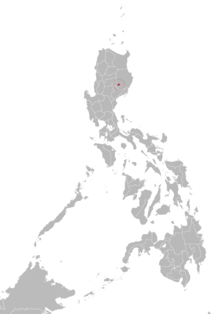Yogad language
Yogad is an Austronesian language spoken primarily in Echague, Isabela and other nearby towns in the province in northern Philippines. The 1990 census claimed there were around 16,000 speakers.[3]
| Yogad | |
|---|---|
| Native to | Philippines |
| Region | Luzon |
Native speakers | (16,000 cited 1990 census)[1] |
Austronesian
| |
| Language codes | |
| ISO 639-3 | yog |
| Glottolog | yoga1237[2] |
 Area where the Yogad language is spoken | |
Classification
Anthropologist H. Otley Beyer describes Yogad as a variant of Gaddang language and the people as a sub-group of the Gaddang people in his 1917 catalogue of Philippines ethnic groups.[4] Glottolog presently groups it as a member of the Gaddangic group; in 2015, however, Ethnolog placed Yogad as a separate member of the Ibanagic language family. Godfrey Lambrecht, CICM, also distinguished separately the peoples who spoke the two languages.[5]
Alphabet
The Yogad alphabet has 21 letters composed of 16 consonants and 5 vowels.[6]
| Majuscule Letter | A | B | K | D | E | F | G |
|---|---|---|---|---|---|---|---|
| Minuscule Letter | a | b | k | d | e | f | g |
| IPA | /a/ | /b/ | /k/ | /d/ | /ɛ/ | /f/ | /ɡ/ |
| Majuscule Letter | H | I | L | M | N | NG | O |
| Minuscule Letter | h | i | l | m | n | ng | o |
| IPA | /h/ | /i/ | /l/ | /m/ | /n/ | /ŋ/ | /o/ |
| Majuscule Letter | P | R | S | T | U | W | Y |
| Minuscule Letter | p | r | s | t | u | w | y |
| IPA | /p/ | /ɾ/ | /s/ | /t/ | /u/ | /w/ | /j/ |
gollark: The bee poll seems to have gone through, so I have bee deployment authorization. Excellent.
gollark: ···
gollark: Also, it turns out that some Discord bots can play osmarks internet radio™, although there is still some instability for some reason.
gollark: ++delete <@341618941317349376> for stalking and apparently now not being transparent about it.
gollark: <@341618941317349376> You have seriously just made the situation worse you idiot triangular.
References
- Yogad at Ethnologue (18th ed., 2015)
- Hammarström, Harald; Forkel, Robert; Haspelmath, Martin, eds. (2017). "Yogad". Glottolog 3.0. Jena, Germany: Max Planck Institute for the Science of Human History.
- "About Yogad". Yogad Kan.https://www.yogadkan.com/about-yogad.html
- Beyer, H. Otley (1917). Population of the Philippine Islands in 1916 (población de las islas Filipinas en 1916) (in English and Spanish). Manila: Philippine Education Co., Inc. p. 22.
- Lambrecht, Godfrey (1959). "The Gadang of Isabela and Nueva Vizcaya: Survivals of a Primitive Animistic Religion". Philippine Studies. 7 (2): 194–218. JSTOR 42719440.
- Yogad: First Primer. The Summer Institute of Linguistics. 1956.
- Davis, Philip W.; Mesa, Angel D. (2000). A Dictionary of Yogad. Munich, Germany: Lincom Europa.
This article is issued from Wikipedia. The text is licensed under Creative Commons - Attribution - Sharealike. Additional terms may apply for the media files.